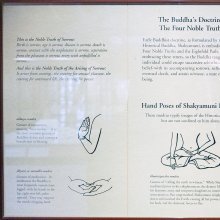Stopping: 2 definitions
Introduction:
Stopping means something in Hinduism, Sanskrit, Jainism, Prakrit. If you want to know the exact meaning, history, etymology or English translation of this term then check out the descriptions on this page. Add your comment or reference to a book if you want to contribute to this summary article.
Images (photo gallery)
In Hinduism
Yoga (school of philosophy)
Source: ORA: Amanaska (king of all yogas): A Critical Edition and Annotated Translation by Jason Birch1) The Stopping (of mind and breath) can be denoted by the Sanskrit terms Rodha or Nirodha, according to the Amanaska Yoga treatise dealing with meditation, absorption, yogic powers and liberation.—Accordingly, as Īśvara says to Vāmadeva: “[...] [Now], I shall define the nature of that highest, mind-free absorption which arises for those devoted to constant practice. [...] By means of an absorption for half a Ghaṭikā (i.e., one hundred and eighty breaths), the highest power [called] Kuṇḍalinī is awake at the base [of the spine] as a result of stopping the mind and breath (manovāta-nirodha). [...]”.
2) The Stopping (i.e., the drawing down of the upward moving breath) is denoted by the Sanskrit term Nirodhana, according to the Dakṣiṇāmūrti (Dakṣiṇāmūrtistotrabhāvārthavārttika), otherwise known as the Mānasollāsa and attributed to a Sureśvarācārya.—Accordingly, while discussing Hathayogic Mudrās as part of Yoga practices: “The contraction [and drawing up] of the downward moving breath and the stopping (nirodhana) [and drawing down] the upward moving breath and the placement of the tongue above the uvula is the practice of Yoga”.
3) Stopping (the movement of the breath) can be denoted by the Sanskrit term Nirodhana, according to the Haṭhapradīpikā of Svātmārāma: an influential 15th-century Sanskrit manual on Hatha-Yoga dealing with techniques to channel one’s vital energy.—Accordingly, while discussing methods for conquering the mind: “Acquiring spiritual knowledge, associating with the wise, abandoning habitual tendencies and stopping (nirodhana) the movement of the breath; according to tradition, [all] these methods are effective in conquering the mind. The [mind] is quickly overcome by these [methods of restraint] like the dust of the earth by streams [of water]”.

Yoga is originally considered a branch of Hindu philosophy (astika), but both ancient and modern Yoga combine the physical, mental and spiritual. Yoga teaches various physical techniques also known as āsanas (postures), used for various purposes (eg., meditation, contemplation, relaxation).
In Jainism
General definition (in Jainism)
Source: The University of Sydney: A study of the Twelve ReflectionsStopping (the influx of karma) (in Sanskrit: saṃvara) refers to one of the “(twelve) reflections” (bhāvanā), according to Śubhacandra’s Jñānārṇava.—Stopping the influx of karma is of two kinds—physical and mental. Putting an end to the acquisition of karmic material by an ascetic is declared to be stopping the influx of karma physically. The cessation of action causing the cycle of rebirth is considered to be stopping the influx of karma mentally. [...] Stopping the influx of karma is like a great tree that is rooted in all the rules of conduct for a mendicant, its great trunk is restraint, its full branches are tranquillity, covered with the blossom of virtue and it is beautiful because of producing whole fruit through the reflections.

Jainism is an Indian religion of Dharma whose doctrine revolves around harmlessness (ahimsa) towards every living being. The two major branches (Digambara and Svetambara) of Jainism stimulate self-control (or, shramana, ‘self-reliance’) and spiritual development through a path of peace for the soul to progess to the ultimate goal.
See also (Relevant definitions)
Query error!
Full-text (+561): Stambhana, Uparati, Uparama, Avarati, Vishtambha, Vishtambhin, Stambhaka, Stobha, Vidharana, Ayama, Aparati, Vegavidharana, Anavasha, Kumbhaka, Yati, Stambhin, Avashtambhana, Nirodha, Rodhana, Rodha.
Relevant text
Search found 219 books and stories containing Stopping; (plurals include: Stoppings). You can also click to the full overview containing English textual excerpts. Below are direct links for the most relevant articles:
The Woods are Still Lovely < [October – December, 2008]
Falaknuma Express < [July – September, 2001]
Downslide < [April – June, 2008]
Shurangama Sutra (with commentary) (English) (by Hsuan Hua)
The honored ones of the past < [Chapter 7 - Concluding Instructions]
Ananda regrets excessive learning and requests samadhi < [Chapter 4 - Ananda’s Fall]
Conclusion: manifestation of pure dharmas < [Chapter 2 - The Bodhisattva Stages]
Vinaya Pitaka (3): Khandhaka (by I. B. Horner)
On Awakening < [1. Going forth (Pabbajjā)]
On the truths at Koṭigāma < [6. Medicine (Bhesajja)]
On the group of five < [1. Going forth (Pabbajjā)]
Ahara as depicted in the Pancanikaya (by Le Chanh)
9. Sammaditthi-sutta (“Perfect View”) < [Appendix 1 - Buddha's teachings on Ahara (Pali texts and English translations)]
3.2. Ahara and the Four Noble Truths < [Chapter 3 - Ahara and specific teachings of the Buddha]
4.2. The enumeration of Ahara < [Chapter 4 - Concept of Ahara in Buddhism]
Fundamentals of Vipassana Meditation (by Venerable Mahāsi Sayādaw)
Things as They Are (by Acariya Maha Boowa Nanasampanno)
